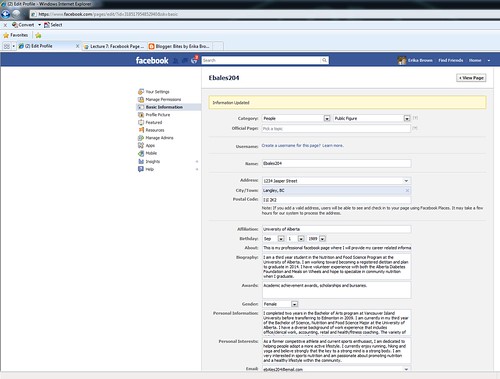 |
| Retrieved April 11, 2012 from http://socialcommunitybanking.files.wordpress.com/2012/01/social_media_puzzle-scaled500.jpg?w=490 |
Another one of Anindya’s points has stayed with me as well. The idea that the internet is just like an elephant, it never forgets. It is certainly true that what happens on the web, stays on the web but unless you have something to hide, this is not a bad thing at all. When I was trying to organize my thoughts about this reflective post I simply scanned back through all the pages of the class blog and then read through my own blog posts as well. The web is the time capsule of our generation; when I needed to go back in time all I had to do is spend a little time and do a little digging. Looking back it is amazing to see how far we all have come since January. I came across Janessa’s intro blog and was reminded of how I felt about social media at the start of this class. Similar to her, I found it to be quite annoying. But when I read my introductory blog post it is obvious how limited my knowledge of social media was: “blogs, tweets, Facebook and YouTube videos”. Certain terms would not have existed in my vocabulary back then. Terms such as pecha kucha, folksonomy, wordle, flickr, audioboo etc. were all completely foreign to me, part of a language I didn't understand. I can say confidently that in the last few months that my knowledge has grown, my attitude has improved and confusingly, my vocabulary both expanded and shrunk (to 140 character bundles) at the same time.
What I have found the most valuable is the actual career prep tools such a the professional Facebook page, CV exercise, interviewing practice, public speaking and powerpoint presentation tips and blogging experience. These are tools that I can absolutely see myself using in the future and I am very glad that I have had this class to hold my hand as I learned how to effectively use my new technology skills in my future career. My eyes have been opened and my attitude has shifted from a fear of technology and social media to one that is keen to embrace its presence and usefulness in our daily lives. I have learned that as long as you are responsible, knowledgeable and open to the process, the many social media outlets that are available to us can be used as valuable tools and enhance our abilities and effectiveness. Before this class I must say I felt a little behind the times, almost as if there was a secret that everyone else knew and I was trying hard not to care that I didn’t get it. I would like to thank Dr. Laccetti, the TA’s and all the students of Ales204 for letting me in on the secret, I think I get it nowJ
One of the most valuable skills we learned this semester was how to interact and engage with other students over the internet. I have included the links to some of my comments and you can scroll through my blog post to see what other students were saying about mine. Also, if you are still wondering what exactly all this “ALES 204” stuff is about, you can check out the youtube video that some students made last semester. It does a great job of explaining the value of this class through the eyes of the students who took it.



